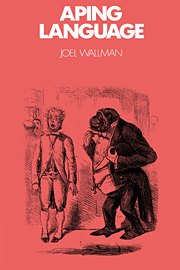Summary
THE NATURE OF LANA'S SYMBOL STRINGS
The assessments of Lana's performance by the Lana researchers take a strong form of the tendency among ape-language researchers to overinterpret their animals' behavior in the direction of human language, elevating to linguistic status behavior more cogently explained in simpler terms. Lana's “sentences” provide a good example.
It is clear that most of Lana's sentences were learned as rote sequences of key presses, yet Rumbaugh et al. gloss each lexigram within them with an English word. The inappropriateness of this practice is most clearly seen in the rendering of the request indicator as “please” (for example “please machine give apple”). Not only is there no evidence to suggest that Lana had any notion of the meaning of “please” or even a child's rudimentary understanding of the sociolinguistic rules governing its usage, but there is also little reason to believe that the other, more concrete terms were meaningful for her either. On the contrary, there is evidence that they were not: long after Lana had learned to “request” these incentives with her sentences, she required 1,600 trials to learn to push the corresponding lexigram when shown an M & M or a banana and asked for its name (Rumbaugh and Gill 1977). The Lana researchers have denied ever suggesting that every element in Lana's strings had linguistic significance (Savage-Rumbaugh and Rumbaugh 1980c), but one must wonder why these elements were nonetheless given English terms. Presumably, this was done to indicate to readers of the publications the concepts the experimenters intended Lana eventually to attain and to convey the pragmatic significance of each term, that is, what would result from its use.
- Type
- Chapter
- Information
- Aping Language , pp. 31 - 37Publisher: Cambridge University PressPrint publication year: 1992



